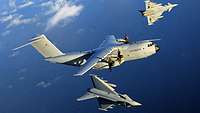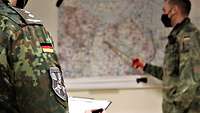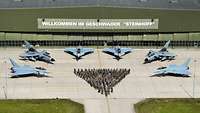BALTIC HUNTER – National Final Training of the Weapons Instructor Course
BALTIC HUNTER – National Final Training of the Weapons Instructor Course
- Datum:
- Ort:
- Laage
- Lesedauer:
- 5 MIN
In the BALTIC HUNTER exercise, some 500 participants and 30 aircraft trained elaborate and complex scenarios in Northern German airspace.
Laage as the Center of BALTIC HUNTER
What the Air Force Weapons School managed to put together in BALTIC HUNTER 2021 was a large-scale flying exercise for the benefit of many more personnel than just the participants of the Weapons Instructor Course (WICWeapons Instructor Course) 02/21. “Participants from all Air Force jet units came to Laage for two weeks, some 500 personnel and more than 30 aircraft, which gave them a chance to plan, execute and debrief exercise missions in direct contact on site”, Lieutenant Colonel Dirk Pingel, Commandant of the Air Force Weapons School, explains.
Complex Scenarios – Highly Demanding Tactical Challenges
Under his command, elaborate and complex scenarios had been designed which confronted the participants and their weapon systems with a wide variety of tasks. The joint operations and exercise scenarios took place both in the air and on the ground. The subjects trained in the phase for the Weapons Instructor Course comprised aerial combat, ground attack, tactical air transport and air defense. However, the project was also intended to provide the operational units of the Air Force with training needed to maintain and enhance their operational readiness. In addition, external participants capable of conducting ground-based air defense, air transport and refueling, electronic warfare, tactical warfare and joint fire support were integrated into the exercise to ensure that the future weapons instructors faced highly demanding tactical challenges.
Pilots as Mission Commanders
More than 30 fixed-wing aircraft and helicopters took off twice a day – Eurofighter and Tornado fighter jets, A330 tanker aircraft and CH-53 helicopters in order to carry out missions, and A-4 Skyhawks and specially equipped Learjets for aerial target presentation purposes. The role of the mission commander – the person responsible for the entire mission, from planning to debriefing – was performed by weapons instructor candidates from the flying sector in all missions.
Mission Commanders Observe from a Bird’s Eye View, Intelligence Personnel Compiles Analyses
The weapons instructor candidates from the tactical air command and control service led the missions from the ground, i.e. from the Schönewalde Control and Reporting Center (CRCCrowd and Riot Control). This gave them a comprehensive view of all aircraft maneuvers during BALTIC HUNTER.
Plans and decisions in turn were based on the estimates of the situation prepared by the candidates from the military intelligence organization. They provided analyses concerning the effectiveness of own assets to the BALTIC HUNTER participants and made recommendations on tactical missions against enemy threats. The goal was to balance the strengths and weaknesses of the individual weapon systems in the most advantageous way possible through detailed planning.
Various Roles
“The weapons instructor candidates in their Blue formations encountered their counterparts in the Red formations in the airspace above Mecklenburg-Western Pomerania and on the ground”, Lieutenant Colonel Pingel describes the course of the exercise missions. “First, they had to detect and identify their assumed enemies on the ground and in the air and then engage them – or simply keep them at a distance without being shot down themselves. The roles were reassigned for every mission so that all pilots in a formation had to act both as attackers and in a defensive role.”
Hostage-Taking and Air Defense on the Part of the Red Forces
The participants in BALTIC HUNTER did not only train and refine their specific roles in the air, however. Ground-based forces involved on both sides in the exercise also trained various scenarios. “The Red forces took hostages, for instance, who had to be freed by the Blue forces, or employed the antiaircraft systems of their specialized unit ‘Polygone’ as threats to keep the Blue jets from achieving their objectives,” Pingel explains.
Close Air Support and Defensive Fighter Patrol on the Part of the Blue Forces
For the Blue forces, the airborne weapon systems, together with units of 1 Surface-to-Air Missile Wing and their PatriotPhased Array Tracking Radar to Intercept on Target systems, protected the airspace above their own positions. The Special Operations Forces Command also participated on the Blue side in the exercise. Together with low-flying Tornado and Eurofighter aircraft, the Blue forces trained operational procedures of close air support above the Altmark Training Area.
Mission Accomplished
“When planning BALTIC HUNTER, we intended to organize a national high-value exercise that would equally enable the members of the flying units and the participants in the ongoing weapons instructor course to attain lasting, ambitious learning objectives. And that is what we managed to achieve.” Lieutenant Colonel Pingel was pleased with the results of BALTIC HUNTER.
Thus, after the end of the exercise, Lieutenant Colonel Pingel was able to draw a favorable conclusion: “The effort we put into the realization of BALTIC HUNTER was definitely worth it for the Weapons School and the Air Force. The fact that it was possible to conduct this exercise without any problems despite an exacting hygiene concept once again emphasizes the professional orientation and the claim of the Weapons School reflected in its motto ‘Fight. Lead. Instruct.’”
New Airspace and Noise Reduction
He also mentioned that special approach and departure procedures had been developed which, together with the airspace established solely for the exercise, had resulted in a reduction of aircraft noise. “It is, of course, impossible to avoid noise completely in a major exercise like this.” In his opinion, BALTIC HUNTER demonstrated that, in addition to providing weapons instructor training, the Air Force Weapons School is also capable of getting a complex, ambitious exercise off the ground, thus enabling all participating units and future weapons instructors to train together for operations.



